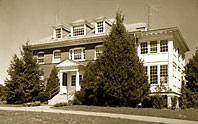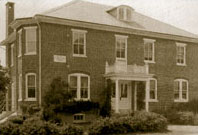Timelines
1910
There are many similarities within the histories of The Lutheran Home at Topton and Tressler Lutheran Services, two of the organizations whose ministries Diakon Lutheran Social Ministries continues.
Both began in the 1800s. Both began as orphanages. And both later developed services for people of all ages, as the use of orphanages ended.
Both also had an identically named building—the Annie L. Lowry Memorial Hospital.
Today, the former hospital on the Topton campus houses some of Diakon’s children services. The building at the former Tressler home was razed some years after the state’s 1963 purchase of the campus for use as a youth development center.
 The first Annie L. Lowry Memorial Hospital was established on Tressler’s Loysville, Pa., campus in 1910. A hospital had already been built in response to the diphtheria epidemic of the time. While donations had been flowing in, the cost was nevertheless significant.
The first Annie L. Lowry Memorial Hospital was established on Tressler’s Loysville, Pa., campus in 1910. A hospital had already been built in response to the diphtheria epidemic of the time. While donations had been flowing in, the cost was nevertheless significant.
Then the home’s staff received an inquiry from an attorney who represented the estate of Mrs. Lowry. A Philadelphia resident and member of the Reformed Episcopal Church, she had bequeathed about $600,000 for charitable work. The attorney’s wife had been a Lutheran as a child and was used to making yearly contributions to the Tressler home.
Thus originated a memorial gift of $8,500. Earlier contributions from congregations and other individuals were then used to furnish the hospital.
 Within months, the attorney also made a contribution to the Topton home. That campus’ Annie L. Lowry Memorial Hospital was finished in 1911. The two-story building cost $5,500 and served as the home’s infirmary until 1956 when “bed patients” were relocated to the then-newly opened Caum Memorial Home in Reading (which later became a Diakon assisted living facility; those services ended in 2005, with hopes of the site becoming a center for Diakon’s regional-based community services).
Within months, the attorney also made a contribution to the Topton home. That campus’ Annie L. Lowry Memorial Hospital was finished in 1911. The two-story building cost $5,500 and served as the home’s infirmary until 1956 when “bed patients” were relocated to the then-newly opened Caum Memorial Home in Reading (which later became a Diakon assisted living facility; those services ended in 2005, with hopes of the site becoming a center for Diakon’s regional-based community services).
A second hospital building, which maintained the memorial to Annie L. Lowry, was constructed on the Tressler campus in the early 1920s when health officials recommended the medical facility be moved farther from dormitories. Parts of the original hospital building were then incorporated into a girls’ dormitory, whose construction was funded by the Women of the Allegheny Synod.


